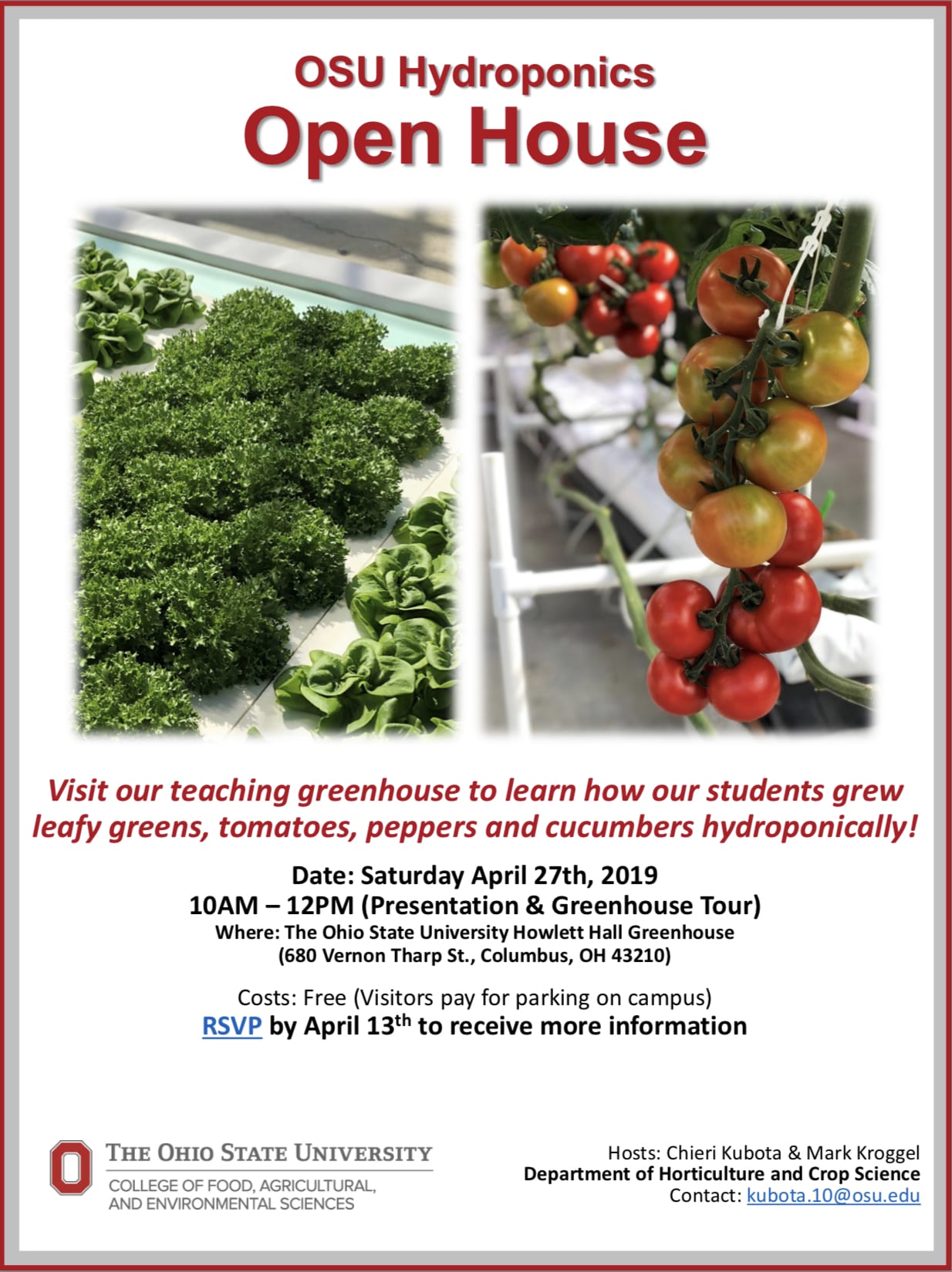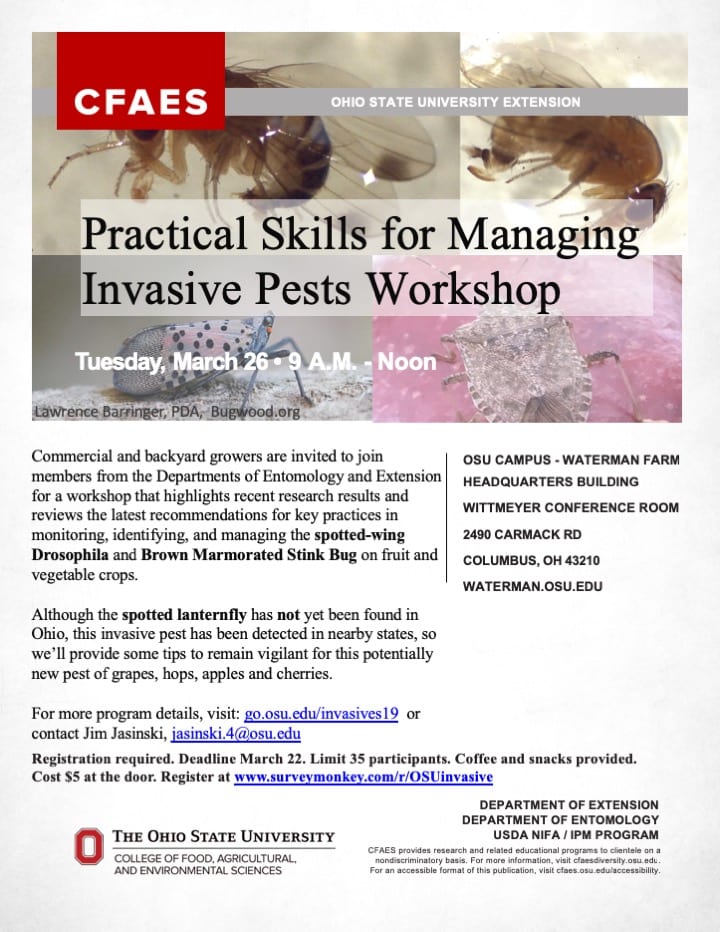Month: March 2019
Tree Planting Workshop
Join Brad Wireman, ODNR Division of Forestry Service Forester, for a tree planting workshop. The program will be held at Wilmington College on Thursday, April 4th, from 6 to 8 PM. For more information, contact Brad Wireman at 614-212-3288 or at Brad.Wireman@dnr.state.oh.us

Leadership Highland Education Day

Members of Leadership Highland toured Laurel Oaks Vocational School in Wilmington, Ohio. Pictured from left to right are: Michelle Unsworth, Liz Brennfleck, Mike Hart, Brooke Beam, Mat Greene, Melissa Elmore, and Destiny Bryson.
Article by Michelle Unsworth, Leadership Highland participant
Photographs contributed by Brooke Beam, OSU Extension, Highland County
Leadership Highland spent their March meeting exploring local education by touring four schools and interacting in panel discussions. The panels discussed serving on a school board, The Southern Ohio Education Service Center, and challenges facing our local superintendents. The participants of Leadership Highland joined the participants of Leadership Clinton for part of the day to discuss the joint educational services offered to both counties.

Dr. Kevin Boys, President of Southern State Community College, hosted participants of Leadership Highland and Leadership Clinton at the SSCC Wilmington Campus for the panel discussions.
Southern State Community College (SSCC) was the first stop of the day. Dr. Kevin Boys, President of SSCC, discussed enrollment and trends. Boys discussed the trend of lower community college enrollment rates when the job market is booming. When the economy shifts, people become more interested in learning a new skill to remain an employable candidate. Since unemployment is low, SSCC’s enrollment is 2,455 students, of which sixty-seven percent attend part-time. Boys also discussed the College Credit Plus program in which High School students take college classes.

Mike Hart led the participants of Leadership Highland on a tour of Laurel Oak’s campus to see the variety of prorgams offered.
Laurel Oaks Vocational campus was the second tour of the day. Mike Hart, Assistant Principal, explained that many of the programs offered at Laurel Oaks maintain enrollment around 25 students per program and acceptance is competitive. Criteria such as GPA and attendance determine acceptance decisions. Laurel Oaks school provides students with a way to earn certificates and experience so they are prepared to enter the workforce directly after high school graduation.

Participants of Leadership Highland and Leadership Clinton, along with Dr. Kevin Boys and the tour guides from Wilmington College, prior to the walking tour of the Wilmington College campus.
Wilmington College was the third stop of the day. The history of the college and the facilities were showcased through a tour of the private school’s campus. Wilmington College offers financial assistance programs to entice local students to stay local during college. The goal after college is for graduates to accept jobs and remain local residents.
Participants of Leadership Highland also traveled to Greenfield Exempted Village School District to tour the McClain High School with Mr. Jason Potts, the High School Principal. In addition to being one of Highland County’s high schools, the school is unique in the sense that it is historic and is home to an extensive art collection.
The superintendent panel addressed educational challenges in modern society. The panel explained how our educational system is vastly different than it was ten years ago. A huge concern is that today’s children are not prepared to be successful. There has been an increase in social and emotional issues that children are experiencing in life, which hinders the learning process. Issues such as poverty, drug abuse, neglect, and social media can leave students emotionally traumatized. Schools are no longer teaching kids solely academics, as schools must adjust their way of thinking and prepare kids to be successful in school and life. Mindy McCarty Stewart, Wilmington City Schools Superintendent, explained how Wilmington’s schools train all teachers (K-12) in trauma training so they know how to interact with children of drug abuse or other emotional issues. They are also using restorative practice training to reintegrate students and involve the parents regarding issues. For example, simply suspending a student does not help anyone, having them take ownership of their actions and learn from it is a better approach.
The big lesson of the day was learning that schools K-12 are evolving to keep up with the social and environmental trends many students face when they are home. Schools have adapted to meet societal needs. Our educational systems are working hard to teach children things they may not have learned at home or to find ways to relate to traumatized children so they open up to learning. This is essential so our young children have opportunities later in life to participate in College Credit Plus programs, attend vocational schools and eventually be ready to attend college if that is their best choice.
The next meeting of Leadership Highland will be a tour of the Ohio Statehouse in April. For more information about Leadership Highland, contact the OSU Extension Office of Highland County at 937-393-1918.
Upcoming Programs:
Join the Highland County Extension Support Committee for the annual Extension/4-H Fundraiser on Saturday, April 6, 2019, in the Rabbit & Poultry Barn at the Highland County Fairgrounds. The dinner will begin at 6 PM. Dinner costs: ages 11 and up are $10.00, ages 4 – 10 are $7.00, and ages 3 and under are $3.00. For more information, contact Kathy Bruynis at 937-393-1918. Donations are appreciated.
Global Climate Change Update with Dr. Thomas Blaine will be held on April 25, 2019, at 6 PM in the Large Meeting Room in the basement of 119 Governor Foraker Place, Hillsboro, OH. Come and learn about the history of climate change, its currents trends, and outlook. Hear how it applies to your backyard, farm, and everyday life. RSVP to reserve your seat by calling 937-393-1918.
Forage Webinar with Christine Gelley will be held on April 30, 2019, at 5 PM in the Large Meeting Room in the basement of 119 Governor Foraker Place, Hillsboro, OH. Gelley will discuss a variety of forage-related topics to help you prepare for the 2019 growing season and upcoming winter. This webinar will provide information for both hay and livestock producers. RSVP to reserve your seat by calling 937-393-1918.
The Germinate International Film Fest will be accepting submissions through June 30, 2019. The festival will be held on August 16 & 17, 2019, in Hillsboro, Ohio. For more information or to apply visit https://filmfreeway.com/GerminateInternationalFilmFest. Contact Brooke Beam at the OSU Extension Office of Highland County at 937-393-1918.
Florida Strawberries signal a start of Spring
Ohio State University Extension, Highland County
Agriculture and Natural Resources/Community Development Extension Educator
A few weeks ago, I took a quick weekend trip to Florida to visit one of the agricultural commodity group festivals I’ve been hearing about for a few years. The Florida Strawberry Festival is held annually at the beginning of March in Plant City, Florida. Plant City is located between Tampa and Orlando along I-4 and the region is one of the bright spots for Florida’s agriculture industry.
As you drive along I-4, you are surrounded by fields of strawberries and family operated farm stands filled with fresh produce. However, the Florida Strawberry Festival has more of a state fair feel rather than a small community agricultural festival. The festival includes concerts by numerous bands (this year’s lineup included Willie Nelson), carnival rides, livestock, and youth sewing and baking contests. Despite the typical festival and fair activities, there is definitely a focus on the local agricultural commodity the festival is appropriately named after and the family farms that make the event possible.

One of the strawberry shortcakes made at the St. Clement Catholic Church’s booth at the 2019 Florida Strawberry Festival.
Sprinkled throughout the many vendors were a wide variety of strawberry items, ranging from t-shirts, hats, cookbooks, and socks to edible delicacies. Local farms had provided visitors with the opportunity to try fresh strawberry lemonade, chocolate covered strawberries, strawberry preserves, strawberry bread, strawberry cookies, and strawberry pizza. One of the most popular stops on the strawberry foodie trail was the St. Clement Catholic Church’s strawberry shortcake buffet.
There are several take-home lessons from this festival. Agricultural producers capitalized by providing numerous ways for visitors to try fresh strawberries. Providing unique items sprinkled throughout the vast fairgrounds encouraged visitors to explore more of the festival and spend more money with local producers and vendors.
If Highland County had a festival focused on one agricultural product, what do you think would be the best representation of the county? Once you have made your selection, think of how many ways that product could be made into another value-added product.
While it is peak season for strawberries in Florida, it is the peak season in Ohio to consider what to plant for this year’s growing season and plan accordingly. Strawberries are grown locally in Highland County and can be an added item to your garden or farm. Depending on the variety of strawberry plants, it is estimated that one strawberry plant may produce up to one quart of fruit during the first fruiting year in Ohio.
For more information about growing strawberries in Ohio, contact the Highland County Extension Office at 937-393-1918.
Upcoming Programs:
Video Production 101 will be held on Monday, March 25, 2019, at 6 PM at the Lynchburg Public Library in Lynchburg, OH. The topic of this program will cover the basics of video productions for beginners and will be presented by Brooke Beam. If you have a small business and would like to incorporate more videos into your marketing plans or you are interested in learning the basics of video production, this program is for you!
The topic of the Highland County Monthly Extension Programming for March will be Storytelling for Video Production. The program will be held on March 27, 2019, at 10 AM. Attendees will learn about the different kinds of documentary films and how storytelling impacts the audience’s perception of videos. The program will be held at Ponderosa Steakhouse in Hillsboro and is free to attend. Attendees are encouraged to purchase lunch on their own at Ponderosa. Please RSVP to reserve your seat by calling 937-393-1918.
Global Climate Change Update with Dr. Thomas Blaine will be held on April 25, 2019, at 6 PM in the Large Meeting Room in the basement of 119 Governor Foraker Place, Hillsboro, OH. Come and learn about the history of climate change, its currents trends, and outlook. Hear how it applies to your backyard, farm, and everyday life. RSVP to reserve your seat by calling 937-393-1918.
Raised Bed Gardening
Submitted by Faye Mahaffey
OSUE Brown County Master Gardener Volunteer
Growing up on the farm we had a huge garden. My mom and I worked in it every day, and my dad would hoe weeds if they got ahead of us. My mom loved flowers and loved to take a vase of cut flowers to church each Sunday. I remember my Grandpa Haines asking my Mom what she had planted so far, and her reply was, “4 rows of Zinnias, 4 rows of Cosmos and 4 rows of Gladiolas.” Not the answer my Grandpa was looking for!
 As my parents aged the garden grew smaller. Finally, we built some raised beds for some tomato plants. We were not canning like we had in the past, and we were tired of fighting weeds. It was nice to be able to mow around the beds and spend less time weeding around plants.
As my parents aged the garden grew smaller. Finally, we built some raised beds for some tomato plants. We were not canning like we had in the past, and we were tired of fighting weeds. It was nice to be able to mow around the beds and spend less time weeding around plants.
When I moved to our current home, the garden was larger. I even attempted to grow some sweet corn, but the raccoons beat me to the harvest. My husband used to have a huge garden because he went up and down between the rows with a tiller. When I arrived on the scene and tried to convince him that tilling so often was creating more weed issues, the garden became mine. I wasn’t interested in canning lots of green beans for just the two of us, so the garden started shrinking in size. I make a batch of pickles every other year and still like to can some chili sauce each year.
Remember the crazy weather we had last summer? Every time it got dry enough in my garden to hoe weeds, it seemed that there were other things I needed to be doing. Then….it would rain again! I threatened to put boards down in between the rows so that I could weed but didn’t get that done either! When it came time to pick green beans, I had to use the weed trimmer in-between the rows! That was the day that I resolved to make some changes.
I knew that I wanted raised beds but wasn’t sure what size or shape. The research started on Pinterest and my Raised Bed Board was soon full of a variety of raised beds. I would sit and look at each photo and made notes about my favorites.
I researched online at Ohioline.osu.edu, the University of Missouri Extension, and Purdue Extension. Of course, I purchased a book, “Raised Bed Revolution” by Tara Nolan and did research at Mother Earth News.
The results are exciting! I have 3 large beds that are 16 feet long, 22 inches high and 4 feet wide. Some fun additions to the garden are 2 pieces of old Pride of the Farm Hog feeders, one of which will be where I plant asparagus. We are building a 2-bin composting station this week.
I am looking at a variety of planting plans and am really interested in a 3-season raised-bed plan that I found in a Garden Project book. I will share more as the weeks pass. For now, there will not be a fence around the beds. But that might change, since I just counted 5 deer walking by my potting shed!
OSU Hydroponics Open House – Saturday, April 27th
Practical Skills for Managing Invasive Pests Workshop
Growing Roses
Submitted by Faye Mahaffey
OSUE Brown County Master Gardener Volunteer
Do you grow roses? There are many gardeners who grow them for their beauty and their “delicious” smell. Me? I can name at least 10 ways that I can completely kill a rose. I am just not cut out to be a Rosarian. I have had rose growers try to
convince me that they have an “invincible” variety that would be safe in my care, but I graciously decline their generous offer. One of my cousins called a few years back and wanted me to be the caretaker of her rose that was a start from our Great Grandmother. I explained to her that she needed to look elsewhere for help, unless she wanted it to find a quick easy death.
As I researched roses for this article, I went to the Purdue University Cooperative Extension Service’s website and printed an 11- page Fact Sheet on Roses. I was already put off by the length and realized that roses usually met their demise in my landscape from lack of winter protection. As you recall, a plant that is needy, doesn’t live long at my place!
The rose is one of the oldest flowers in cultivation and is still considered one of the most popular garden flowers today. Most modern roses are descendants of eight European and Asian rose species. The elaborate flower forms and colors of today are the result of extensive breeding and hybridizing that began in the 1800s.
Roses can be grouped into 3 classifications according to their growth characteristics: bush, climbing, and shrub. (And yes, I have killed one of each.)
Are you interested in learning more about growing roses? The OSUE Brown County Master Gardener Volunteers will be hosting a garden seminar on Thursday, March 21, 2019, at the Mt. Orab campus of Southern State Community College from 7:00 p.m. to 8:00 p.m. in Room 208. Naturalist, Denise Bollinger, of Creek’s Edge Farm Retreat, will talk about different varieties of roses, picking a spot to plant them, preparing the soil, and some tips to help keep your roses happy!
In Denise’s words, “It’s hard not to love a rose…the smell, the color, the pure beauty. But often, they can be problem prone and fussy; so many gardeners tend to shy away from growing these delicate flowers.”
We hope that you will mark your calendars and join us for the March 21 garden seminar! I will be there taking copious notes on “how NOT to kill a rose”.
My raised beds are built and in place! It is exciting times at the Mahaffey’s. I have my graph paper out and am in the beginning stages of my planting design. Stay tuned for more about raised bed gardening!








